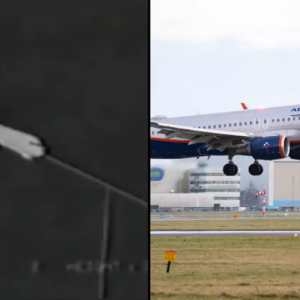On Christmas Eve in 1944, the snow turned red with blood
During the Battle of the Bulge, thousands died — including a young nurse whose body was delivered home swaddled in parachute cloth
German infantrymen pass by burning captured American vehicles during the drive into Allied lines on the Western Front during the Battle of the Bulge. (AP)
On Christmas Eve 1944, in the besieged Belgian town of Bastogne, a U.S. Army doctor named John T. Prior was about to write a letter for a dying officer in the makeshift hospital next door.
It was a lousy night before Christmas. It was freezing cold. Food was scarce. Medicine was almost gone. And the hospital was jammed with wounded soldiers and a young Belgian nurse who was caring for them.
As machine gun tracers arced across the heavens and a chaplain held a service in a stable, one of Prior’s men offered him a cup of champagne to mark the holy night. But as they paused to drink, they heard the scream of a falling bomb, followed by a tremendous explosion at the hospital.
Seventy-five years ago this week, the biggest and deadliest single battle of World War II for American soldiers climaxed during what became known as the Battle of the Bulge.
Nine days before, outnumbered Americans had been assailed by 400,000 Germans and 1,400 tanks and assault guns.
About 19,000 Americans were eventually killed. Some 47,500 were wounded, and 23,000 were captured or were missing in action.
The battle riveted people back home, and the siege of Bastogne, which was its centerpiece, made headlines across the country. A stubborn U.S. general famously told the Germans “NUTS!” when they demanded Bastogne’s surrender.
The siege would be broken by the flamboyant Lt. Gen. George S. Patton Jr., whose Third Army made a dramatic dash to the rescue. And, while Patton’s lead tank, nicknamed “Cobra King,” shot its way into Bastogne on the day after Christmas, the battle would go on for another month.
But for “Jack” Prior, 27, a poor kid made good from St. Albans, Vt., the battle came down to one awful moment, one enemy bomb, in one spot on Christmas Eve.
2nd Lt. John Prior in an undated photograph. He was a doctor in Belgium during the Battle of the Bulge. (US Army)
“I ran outside to discover that the three-story apartment serving as my hospital was a flaming pile of debris about six feet high,” Prior wrote later. “My men and I raced to the top … and began flinging burning timber aside looking for wounded, some of whom were shrieking for help.”
Inside, about 20 of Prior’s wounded GIs were killed, along with the nurse, Renee Lemaire, whose body was later found severed in half. Prior wrote that he wrapped her in parachute cloth and brought her home to her father.
 Renee Lemaire in an undated photograph. (Courtesy of Martin King)
Renee Lemaire in an undated photograph. (Courtesy of Martin King)
She had always hoped to collect some parachute cloth to use for a wedding dress, he remembered, and he had snagged some for her as a Christmas present.
The Battle of the Bulge unfolded during the final December of the war, when Nazi Germany launched a massive, last-ditch counterattack against Allied forces that had been surging across France and Belgium since the D-Day landings in Normandy in June.
The war in Europe had been underway for five years. Adolf Hitler, the German dictator, was fighting the Russians in the East and American, British, Canadian, French and other forces in the West.
Germany was being crushed between the two fronts and seemed doomed.
But Hitler believed that a giant surprise attack in the West might split the front and knock the Canadians, and perhaps the British, out of the war, according to British historian Antony Beevor.
Hitler also thought a strike aimed at American soldiers would be easier than one aimed at the British, wrote American military historian Trevor N. Dupuy.
The German offensive, named “Autumn Mist,” was launched on Dec. 16, 1944, with the aim of punching through the Allied lines and reaching the port of Antwerp, Belgium.
It blitzed through a weakly held American sector in a rugged and forested region called the Ardennes.
Thousands of Americans were killed and wounded. An entire American division — the 106th — was destroyed, and 8,000 of its men surrendered.
Another division, the green 99th, was shattered. The German attack created a huge bulge in the Allied lines, giving the battle its name.
Fighting was savage. Tanks fired at each other from point-blank range. One American squad leader swung his jammed rifle like a club as he led his men in an attack. A badly wounded GI begged his buddies to shoot him.
The Germans used tanks with flame throwers. American planes dropped napalm.
On Dec. 17, at a crossroads called Baugnez — often referred to as Malmedy — the Germans captured a large group of Americans and executed 84 of them.
Later that day, they murdered eight more at Ligneuville, according to Beevor.
Belgian civilians were not spared. More than 100, mostly women and children, were murdered near Stavelot.
An older couple trudge toward their home in Bastogne, Belgium, on Jan. 6, 1945, after Allied forces lifted the siege on the town by Nazi Germany. (AP)
A Catholic priest and a school principal were killed, and a man was beaten to death with hammers because the Nazis had found a homemade American flag in his basement, Beevor wrote in his 2015 book, “Ardennes 1944: The Battle of the Bulge.”
By Friday, Dec. 22, word of the Malmedy massacre had reached American soldiers, and they responded in kind.
As a group of about 20 Germans waved a white flag and tried to surrender that day, they were beckoned forward by an American sergeant and then gunned down as they emerged from the woods.
At first, the offensive had great success. Nazi commandos, dressed in American uniforms and manning captured American tanks, added to the chaos.
“You cannot imagine what glorious hours … we are experiencing now,” a German officer wrote to his wife. “The snow must turn red with American blood.”
But as the German tide swept westward, the vital road junction town of Bastogne held out. Both sides wanted the place, but the Americans got there first and soon were virtually surrounded.
Prior was dispatched to a suburb northeast of Bastogne called Noville on Dec. 19, just as the Germans were tightening their noose.
He set up an aid station in a pub, but the enemy quickly turned Noville into “a shooting gallery” where one had to crawl to avoid being hit.
When the Americans decided to withdraw to Bastogne, Prior wrote that he planned to stay with the wounded and surrender. “I asked for volunteers to stay with me but the silence was deafening!” he recalled in a 1972 essay.
The crew of some departing tanks stopped to help. They tore some house doors off their hinges, strapped the wounded to the doors and attached the doors to the tanks.
The group fought its way back toward Bastogne and was rescued en route by the U.S. 101st Airborne Division, which had been hurried there to bolster the town’s defenses, Prior wrote.
Bastogne and its outskirts were then being pounded by the Germans, who planned a Christmas Day attack to overrun the place.
It was bitterly cold, and a foot of snow was on the ground, he remembered.
One GI was found frozen to death in his foxhole. Others had frostbitten feet. On the night of Dec. 23 into the early morning of the 24th, the temperature fell into the single digits.
The turrets in armored vehicles froze. Tires on some artillery pieces froze to the ground, George E. Koskimaki, an author and radio operator with the 101st, wrote in a 1994 collection of battle reminiscences.
Blood plasma froze solid, and the bags had to be held under an armpit to be thawed.
Prior had about 100 wounded men in his hospital, and there were 600 more on the dirt floor of a nearby riding hall.
He needed help.
It came in the form of two intrepid young women: Lemaire, 30, who would lose her life treating American soldiers, and a 23-year-old Afro-Belgian nurse named Augusta Chiwy, whom Prior identified in his memoir as the “Congo girl.”
Chiwy (pronounced she-wee) was born in Africa, in what was then known as the Belgian Congo, according to British military historian and filmmaker Martin King. Her mother was black, and her father was a white Belgian veterinarian from Bastogne, where she wound up spending much of her childhood.
Augusta Chiwy is shown at the top of the cockpit of a downed C-47 in this undated photograph. (Courtesy of Martin King)
Battling the racism that pervaded Belgium at the time, Chiwy became a nurse in 1943 and worked in a hospital in Leuven, about 90 miles north of Bastogne, according to King’s 2017 book, “Searching for Augusta: The Forgotten Angel of Bastogne.”
She had made an arduous journey home to Bastogne to visit her father for Christmas, according to King. She arrived the day the battle began.
As Bastogne was pulverized by German artillery, Lemaire had come to the hospital to volunteer on Dec. 21, Prior later wrote. She mentioned to another officer that there was a second nurse in Bastogne.
“I should point out,” she said, “that she isn’t white,” according to King.
Prior didn’t care. He went to Chiwy’s father’s home and asked for her help. She agreed to pitch in and followed him to the hospital, where there was no electricity and no running water, but scores of horribly wounded and dying soldiers.
Some patients from the racially segregated American army did care about Chiwy’s parentage.
When one soldier objected to being treated by her, Prior told him that if he didn’t like it, he could join the ranks of the frozen corpses outside, King wrote.
Chiwy helped with the worst cases.
“The Congo girl was always in the thick of the splinting, dressing, and hemorrhage control,” Prior remembered, while Lemaire “shrank away from the fresh, gory trauma.”
King, the author, wrote that at one point, Prior and Chiwy amputated a soldier’s hand and foot using cognac as an anesthetic and a serrated Army knife as a scalpel. (She would later join Prior for the Christmas Eve champagne break in the building beside the hospital and escape the bomb strike.)
Meanwhile, someone played Bing Crosby’s “White Christmas” on an old gramophone. Two GIs at a frigid outpost heard German soldiers singing “Silent Night.” And elsewhere in the “Bulge,” undelivered Christmas cards and packages had already been piled up, drenched with gasoline and set on fire, to keep them from the enemy.
On Christmas Day, the Germans attacked.
But the Americans were waiting, and smashed them. Smoking German tanks littered the battlefield, and Patton’s men arrived the next day.
The Battle of the Bulge would go on for another bloody month, and the war in Europe until May 1945.
But one officer, Lt. Robert I. Kennedy, wrote author Koskimaki that he would always remember Christmas in Bastogne, especially dinner:
“One can of hamburger patties and one can of mashed potatoes so cold they were almost frozen. No one had any mess kits or any utensils, so each man reached dirty, bare hands into one can for one patty and with the other dirty hand for a fistful of mashed potatoes.”
“So I never forget my Christmas dinner of 1944.”
An Army jeep heads down a cleared street in Bastogne on Jan. 8, 1945, after Lt. Gen. George S. Patton Jr. and his Third Army made a dramatic dash to rescue the besieged Belgian town from the Nazi German assault. (AP Photo/Charles Haacker)
News
The “Red Zone” – Land Still Abandoned Due to the Dangers Left by the First World War
The “Red Zone” – Land Still Abandoned Due to the Dangers Left by the First World War In the aftermath of the First World War, large areas of northeast France were left in ruin. Years of constant siege warfare along…
Before Becoming a Big-Name Actor, Richard Todd was a Paratrooper Who Fought at Pegasus Bridge
Before Becoming a Big-Name Actor, Richard Todd was a Paratrooper Who Fought at Pegasus Bridge Photo Credit: 1. Sgt. Christie, No. 5 Army Film & Photographic Unit / Imperial War Museums / Wikimedia Commons / Public Domain 2. Silver Screen…
The Potsdam Giants: A Prussian Infantry Regiment Of Nothing But Very Tall Soldiers
The Potsdam Giants: A Prussian Infantry Regiment Of Nothing But Very Tall Soldiers Frederick William I inspecting his giant guards known as The Potsdam Giants, a Prussian infantry regiment No 6, composed of taller-than-average soldiers. Frederick William I of Prussia,…
Ellen DeGeneres cuts a very casual figure as she drives around in her Ferrari
Ellen DeGeneres cuts a very casual figure as she drives around Montecito in her Ferrari… while preparing to embark on her stand-up tour Ellen DeGeneres cut a very casual figure as she made her way around Montecito on Tuesday morning. The…
“I’m heavily tattooed and keep getting rejected for jobs – it’s not fair”
Heavily tattooed OnlyFans star, 23, with multiple piercings on her FACE slams TJ Maxx for rejecting her for a job – accusing retailer of unfairly judging her dramatic look A woman has accused TJ Maxx of rejecting her for a…
All 75 passengers killed in plane crash after pilot let his chirldren control the plane
Praying, turning the engine off by accident and letting KIDS play with the controls: The worst blunders made by pilots before a crash revealed Every time we board a plane, we put our lives in the hands of the pilot….
End of content
No more pages to load
















